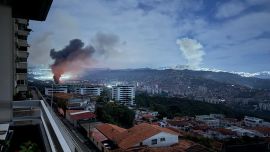Forensic experts said Thursday that Facundo Astudillo Castro, the late 22-year-old who went missing in Buenos Aires Province at the end of March,died of suffocation, though they added it was not possible to determine if the young man’s death was a homicide.
A statement from María Gabriela Marrón, the judge leading the investigation into the death, confirmed that an autopsy had concluded that the "death of Facundo Astudillo Castro (22 years old) was caused by asphyxia by submersion (drowning)."
However, the magistrate added that given "the advanced state of skeletonisation of the corpse limited the possibilities of knowing the manner of death, forensic science could not determine with scientific rigour whether it was one or another type of violent death: suicidal, homicidal or accidental."
The findings came from an autopsy carried out by the world-renowned Argentine Forensic Anthropology Team (EAAF), which officially joined the investigation last month. Marrón confirmed in early September that the remains of a skeleton found in a rural part of Buenos Aires Province on August 15 were from Castro’s body.
The statement added that the skeletal remains did not show injuries of trauma that happened prior to death and there was no evidence of “structures of metallic density, similar to elements that may correspond to those that cause injuries or injuries,” such as bullets from a firearm or a knife.
The experts found that there was no defining evidence that a third party had been involved in the desk, nor did it find elements to suggest the body had been moved before its discovery. What injuries were on the body – such as the loss of some teeth – could have happened after Castro’s death, possibly from exposure to the environment and predatory animals.
While confirming the manner of death, the lack of a clear conclusion over the manner of Castro’s death will do little to calm suspicions held by the late man’s relatives, who believe members of the Buenos Aires Province police force were involved in the tragedy.
Checkpoint
Castro was last seen on April 30 in the Villarino partido, after being stopped by police for breaking the lockdown imposed to tackle the spread of the coronavirus pandemic. He had departed from his home in Pedro Luro and was reportedly on his way to Bahía Blanca to see his former partner, though he never arrived at his destination.
The Buenos Aires Province Force, the largest security apparatus in the country with 90,000 troops, says that Castro was stopped and issued a certificate for violating the quarantine, before being allowed to continue on his way.
The last photograph of Castro, taken before his death by what investigators believe was a police officer’s mobile phone, shows him handcuffed next to a police vehicle at a police checkpoint.
Partial remains of the 22-year-old’s corpse were eventually found, more than 100 days after it went missing, in Villarino Viejo, just five kilometres away from where he was last seen.
The missing man’s family and their lawyers have repeatedly alleged that provincial police officers were involved in his disappearance. Many relatives seem convinced that foul play was involved.
Cristina Castro, Facundo’s mother, in particular has been exceptionally critical of the authorities and their handling of the case, especially Buenos Aires Province Security Minister Sergio Berni.
"My son did not commit suicide or have an accident. The Buenos Aires [Province] Police killed him," she said on Thursday, speaking after the results of the autopsy were made public.
"I'm not going to stop until the culprits are in jail," she said forcefully.
Concerns
Human rights organisations have expressed concerns over the case, considering it a forced disappearance, while demonstrators demanding justice for the late 22-year-old have taken to the streets in recent weeks.
All the available evidence points to “a case of forced disappearance followed by death," said Cristina Castro’s lawyer, Luciano Peretto, on Thursday, speaking at a videoconference event organised by Amnesty International Argentina.
Cristina Castro has repeatedly called for the investigation to be transparent and has met with President Alberto Fernández and Buenos Aires Province Governor Axel Kiciloff to push her claims. Both leaders have vowed there will be no cover-up.
"The conclusion of the study is that Facundo died violently," said Virginia Kreimer, an expert attached to the criminal complaint who signed the EAAF autopsy with partial dissent, saying it raised doubts over the cause of death.
"We [can] rule out that it is an accident or suicide, which would be absolutely unfeasible due to the circumstances," she said.


















Comments